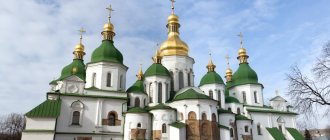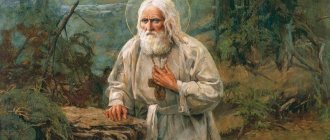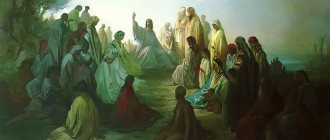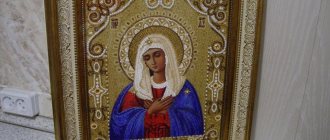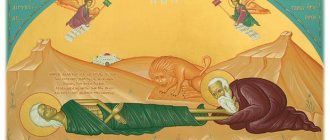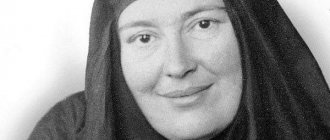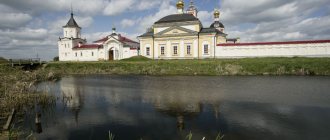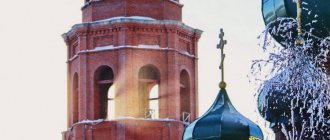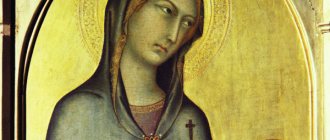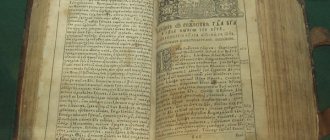One of the oldest images of the Mother of God is considered to be the icon of the Mother of God “Oranta” (Praying). Another name that is often found is the icon of the Mother of God “Panagia” (All-Holy). In terms of iconographic type, the “Great Panagia” icon goes back to the famous Blachernae icon of the Mother of God from Constantinople.
In Russia, the most ancient icon of this type is the “Yaroslavl Oranta” (“Great Panagia”), which, according to legend, was painted by the first Russian icon painter, the Monk Alypius, a monk of the Pechersk Monastery in Kyiv.
Description of the icon
Traditionally, the icon of the Mother of God “Oranta” depicts the Mother of God with her arms raised and outstretched to the sides, with Christ Emmanuel in a circle on her chest, who also has his arms outstretched in a blessing gesture, which is rare: as a rule, on the icons of the Mother of God the Child or the Youth Christ is blessed with one hand .
The name “Emmanuel” is borne by any image of the Savior in adolescence, including on icons of the Mother of God. His look is filled with childish seriousness, and the look of the Mother of God is filled with meekness and humility before the Will of God.
Subsequently, the same type of iconography became characteristic of the icons of the Mother of God “The Sign”, “The Life-Giving Spring” and “The Inexhaustible Chalice”.
The “Panagia Sumela” icon belongs to a slightly different iconographic type, which is also classified as an “Oranta” (“Panagia”) type. This is a half-length image of the Mother of God with Jesus on her knees.
This icon has its own dramatic story. Tradition says that this face was painted by Saint Luke himself. Miraculously, the icon ended up on a bare rock ledge, and the Mother of God herself ordered two Greek monks to build an Orthodox monastery here, called Sumela. This happened in the 4th century, and since then it has become widely known as the monastery of Our Lady of the Black Mountain.
The “Life-Giving Spring” type refers to Oranta, but does not always correspond to it
The last type of icon is called the “Life-Giving Spring.” History goes back to the Byzantine Emperor Leo
To him, a simple warrior, the Mother of God showed him the place of the miraculous spring and healed the blind man. When Leo became emperor, he ordered a temple to be erected on the site of the source.
The Virgin and Child are depicted sitting or standing in a huge bowl standing in a reservoir. The reservoir is filled with healing water: people drink the water and are healed
The “Life-Giving Spring” type is sometimes different from other icons of Our Lady of Oranta. Sometimes the Mother of God is not in the Oranta position.
This iconographic tradition is closer to the image of Nikopeia Kyriotissa, which itself, in turn, goes back to the “Sign” iconographic type
On some icons of the “Life-Giving Spring” type, the Mother of God is depicted in the tradition of the Mother of God of Nikopeia, who simply supports Christ
A prayer is read in front of the icon:
Oh, Most Holy Virgin, Mother of our Lord Jesus Christ! You are the Mother and patroness of all who come running to You, look with compassion on the prayers of Your sinners and humble children.
You, called the Life-Giving Source of grace-filled healings, heal the illnesses of the afflicted and pray to Your Son,
Our Lord Jesus Christ, may He grant spiritual and physical health to all who come to You,
having forgiven us our voluntary and involuntary sins, He will give us everything we need for eternal and temporal life.
You are the joy of all who mourn, hear us, the sorrowful;
You are the quencher of sorrow, quench our sorrow too;
You are the seeker of the lost, and do not allow us to perish in the abyss of our sins,
but always deliver us from all sorrows and misfortunes and all evil circumstances.
To her, our queen, our indestructible hope and irresistible intercessor,
do not turn Your face away from us for the multitude of our sins,
But stretch out to us the hand of Thy motherly mercy and create with us a sign of Thy mercy for good: show us Thy help and prosper in every good deed.
Turn us away from every sinful undertaking and evil thought,
may we always glorify Your most honorable name,
magnifying God the Father and the Only Begotten Lord Jesus Christ and the Life-giving Holy Spirit with all the saints forever and ever. Amen
One of the most common images of Our Lady Oranta is located in Kyiv, in the St. Sophia Cathedral
The icon was called the “Unbreakable Wall” because it remained intact throughout the difficult history of Kyiv.
By leaving a comment, you accept the user agreement
The meaning of the icon of the Mother of God “Oranta”
In iconography, each element of the image has its own meaning. Thus, on the icon of “Theotokos Oranta,” the raised hands of the Mother of God are turned with their palms towards Heaven, which symbolizes her intercession before the Creator for every, even sinful, soul.
On the sleeves of the Mother of God there are bands in the form of wide ribbons with cords that tighten the sleeves at the wrist.
This element of the liturgical vestments of priests symbolizes the patronage and service of the Orthodox Church
In the view of the Orthodox, the Panagia icon expresses the basic Christian dogmas, which include the virgin birth and the two essences of Jesus Christ - Divine and Human. Here Christ Emmanuel personifies the Eucharist - the main church sacrament of communion with the Body and Blood of Christ.
Oranta - an ancient prayer position of Jews and pagans
The Latin word orans translates as “praying.”
There are different body positions for offering prayers in different religions. The “oranta” prayer position has been known to Jews since ancient times.
The person stands straight, arms raised and bent at an angle, palms open and facing away from the person.
The first Christians were members of the Jewish community and observed Jewish rituals
The pose was borrowed by Christians. At first they depicted Old Testament characters like this: Noah, Abraham, Isaac, Daniel. Then Oranta assigned herself to the Mother of God.
Initially, Our Lady of Oranta was depicted without the Christ Child
How do the Oranta (Panagia) icons help?
The Mother of God has always been the Heavenly Intercessor, the Patroness, and for this they turn to Her, praying for the salvation of the soul, for the healing of physical and mental ailments, for support in moments of difficult life trials, and she really helps.
The Oranta-Panagia icons have incredible power of influence: they help to gain a clear understanding of the true path, bestow spiritual enlightenment, and protect from the evil thoughts of enemies. The power of the Oranta icon is so great that it is capable of protecting entire countries from enemy attack; it is not for nothing that the Queen of Heaven appears on it in all Her greatness and power.
Our Lady Oranta
/ > Iconography > Mother of God > Oranta
Oranta. Mosaic “Unbreakable Wall”, XII century, St. Sophia Cathedral, Kyiv
Images of the Mother of God standing with her hands raised in a prayer gesture have been known since ancient times. They are found in the mosaics of Byzantine churches, and in the decoration of Catholic churches, and in Russian icon painting. Moreover, the oranta, as this iconographic type is called, was found among early Christians, as evidenced by the paintings in the catacombs of ancient Rome. A symbol of forgiveness in the face of the Mother of God, stretching out her hands in prayer for the entire human race, it still remains one of the most common subjects in Christian fine art.
Oranta, which means “praying” in Latin, combines different types of images of the Virgin Mary, also known as “Panagia” (Most Holy), “Great Panagia” or “Sign”. Icons widespread in Rus', such as the “Inexhaustible Chalice” and complex genre compositions, including images of the holidays of the Ascension and Intercession, represent the development of the orant icon painting type. The common thing that unites them all is the very principle of depicting the Mother of God, who is painted full-face, full-length or waist-length, with her hands raised to the sky in a prayerful gesture.
The image of the Oranta itself has been known since ancient times and is associated more with monumental and decorative art (frescoes, mosaics, sculpture) than with icon painting. With the end of the era of iconoclasm, it became widespread in the design of Byzantine and later Russian churches. Traditionally, images of the praying Mother of God are located in the upper register of the paintings, on the altar barriers and in the conchs of the apses and sometimes reach an impressive size. Thus, the height of the mosaic oranta in the St. Sophia Cathedral in Kyiv, dating back to the 12th century and revered as miraculous, is just under five and a half meters. It is interesting that, despite being over eight centuries old, the mosaic, called the “Unbreakable Wall,” has avoided the slightest loss and has survived to this day in its original form.
Due to tradition and Orthodox dogma, independent images of the praying Mother of God were little used in icon painting. Much more common here is the “Sign” variety of the oranta, which is distinguished by the fact that against the background of the Mother of God’s chest there is an image of Christ Emmanuel, who is written with his arms outstretched in prayer, translucently, or in a special environment - a cartouche. In this interpretation, the meaning of the icon shifts from intercessory prayer to the idea of the Incarnation as the main motif of the iconography of the Mother of God as a whole.
Oranta. Novgorod Sign of the Mother of God, XII century, St. Sophia Cathedral, Veliky Novgorod
The composition of the Mother of God praying with Christ comes from Byzantine culture, but it became widespread in Russian icon painting. The name “The Sign” goes back to the legend about the miracle of the myrrh flow of the icon “The Sign of the Most Holy Theotokos,” which occurred on November 27, 1169 during the assault on free Novgorod by the troops of the Vladimir prince Andrei Bogolyubsky. After one of the arrows hit the ancient icon of the Mother of God during the religious procession, she turned her face to the city and began to shed tears. According to legend, Novgorod Bishop John then exclaimed: “Oh, a wondrous miracle! How do tears flow from a dry tree? To the queen! You give us a sign that you are praying before your son for the deliverance of the city.” Inspired by the miracle, the Novgorodians recaptured the city, and the icon, called “The Sign,” began to be revered as miraculous and served as the basis for many lists.
The image of the Mother of God praying with Jesus Christ is a common subject in Orthodox icon painting. The Abalak, Narva, Tsarskoye Selo, Kursk-Root signs are known and widely revered in Rus'. A special place in this series is occupied by the miraculous icon of the Mother of God “The Inexhaustible Chalice”, which is distinguished by the fact that Christ is depicted here not in a cartouche, but in a golden cup. The icon was found in 1878 in the Vvedensky Vladychny Monastery in the city of Serpukhov and became the basis for two revered miraculous lists that have survived to this day. Every year the Serpukhov monastery receives thousands of new pilgrims who pray before the “Inexhaustible Chalice” for deliverance from alcoholism and other addictions.
Prayer before the icon
Oh, Most Holy and Most Blessed Mother of our Sweetest Lord Jesus Christ! We fall down and worship You before Your holy, miraculous icon, remembering the wondrous sign of Your intercession, which was revealed to the great Novograd during the days of the invasion of this city. We humbly pray to You, the All-Powerful Intercessor of our race: just as You hastened our fathers of old to help, so now we, weak and sinners, grant Your Motherly intercession knowledge and care. Save and preserve, O Lady, under the roof of Your mercy, the Holy Church, Your city, our entire Orthodox country and all of us who fall to You with faith and love, tenderly asking with tears for Your intercession ́nia. Hey, All-Merciful Lady! Have mercy on us, overwhelmed by many sins, extend your God-receiving hand to Christ the Lord and intercede for us before His goodness, asking us for forgiveness of our sins, pious peace His life, a good Christian death and a good answer at His Last Judgment, yes, we are saved by Your omnipotent Through our prayers, we will inherit the bliss of paradise and with all the saints we will sing the Most Honorable and Magnificent Name of the Venerable Trinity, the Father and the Son and the Holy Spirit, and Your greatness is merciful to us die forever and ever. Amen.
( 4 ratings, average: 4.25 out of 5)
The icon of the “Inexhaustible Chalice” type has the siege of Nicaea as a backstory
Another type of icon, painted in the style of Oranta, is called the “Inexhaustible Chalice” and goes back to the Nicene Icon of the Mother of God.
A certain Constantine, during the siege of Nicaea in 304, violated the icon of the Mother of God and was punished.
The Mother of God and Christ Emmanuel stand in the pose of Oranta. Christ stands in the Chalice of Communion.
The icon of the Mother of God “Inexhaustible Chalice” is kept in the monastery in Serpukhov
Before the icon “Inexhaustible Chalice” they pray like this:
Oh, Most Gracious Lady! We now resort to Your intercession, do not despise our prayers, but graciously hear us, wives, children and mothers,
and heal those who are obsessed with the serious illness of drunkenness and for this from your mother,
The Church of Christ, and the salvation of our fallen brothers and sisters and relatives.
O Merciful Mother of God, touch their hearts and soon restore them from their sinful falls,
Bring them to saving abstinence. Pray for Your Son, Christ our God,
may He forgive us our sins and not turn away His mercy from His people,
but may he strengthen us in sobriety and chastity. Accept, Most Holy Theotokos,
prayers of mothers who shed tears for their children, of wives who weep for their husbands,
children, the orphan and the needy, those left astray, and all of us who fall before Your icon.
And may this cry of ours, through Your prayers, come to the Throne of the Most High.
Cover and keep us from the evil deception and all the snares of the enemy, and in the terrible hour of the exodus of our help, help us pass through the stumbling-blocking airy ordeal with Your prayers, deliver us from eternal condemnation,
May God's mercy cover us forever. Amen.
The celebration of the icon takes place on May 18.
